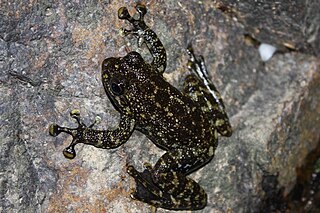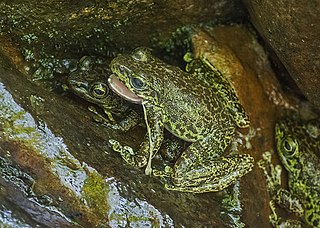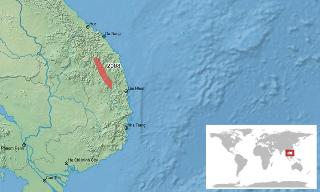
Hong Kong cascade frog or Hong Kong torrent frog is a species of true frog from southern coastal China, once thought to be endemic to Hong Kong. Their eggs are laid on rock faces in the splash zones of cascades. In Hong Kong, it is a protected species under Wild Animals Protection Ordinance Cap 170.

Amolops formosus, also known as Assam sucker frog, beautiful stream frog, Assam cascade frog, or hill stream frog, is a species of frog found in high gradient streams of northern India, northern Bangladesh, and Nepal, possibly also Bhutan, although these records may represent confusion between Amolops himalayanus and this species; the latest available IUCN assessment from 2004 treats A. himalayanus as a synonym of A. formosus.
Amolops monticola is a species of frog in the family Ranidae, the "true frogs". It is found in the Northeast India, eastern Nepal, and western China, although there is some uncertainty regarding the Chinese records. It probably also occurs in the intervening Bhutan. Common names mountain sucker frog, mountain stream frog, mountain torrent frog, and mountain cascade frog have been coined for it.

Hose's frog is a true frog species with a wide range in Southeast Asia. This species was named after zoologist Charles Hose.

Odorrana aureola, also known as the Phu Luang cliff frog or gold-flanked odorous frog, is a true frog species from northeastern Thailand. The specific name aureola is Latin and means ornamented with gold, in reference to the characteristic yellow markings on the limbs and flanks of this frog. It is notable for its ability to change color between green and brown, according to the surroundings.

Anomaloglossus wothuja is a species of frog in the family Aromobatidae. It is endemic to Venezuela and is only known from its type locality, the base of Cerro Sipapo, in the Amazonas state. It appears to be endemic to the Cerro Cuao massif but might occur more widely in similar granitic areas.

Sarcohyla labeculata is a species of frog in the family Hylidae. It is endemic to the Sierra Mixe in Oaxaca, Mexico. This species was resurrected from synonymy of Sarcohyla bistincta in 2018, while at the same time bringing Sarcohyla calthula and Sarcohyla ephemera in its synonymy. Common name Mixe streamside treefrog has been proposed for this species, whereas the common names yellow-robed treefrog and Cerro Las Flores spikethumb frog referred to the former S. calthula and S. ephemera, respectively.

Leptobrachella tuberosa, also known as the granular toad, is a species of frog in the family Megophryidae. As currently known, it is endemic to the Central Highlands of Vietnam in Gia Lai, Quảng Nam, and Thừa Thiên–Huế Provinces. Its true range is probably wider as suitable habitat extends further north and east, reaching northeastern Cambodia and southeastern Laos. The specific name tuberosa is derived from the Latin tuberosus, meaning "full of protuberances".

Amolops larutensis is a species of frog in the family Ranidae that is found in the Malay Peninsula from southernmost Thailand to Malaysia; records further north probably represent A. panhai.

Amolops spinapectoralis is a species of frog in the family Ranidae, the "true frogs". It is at present only known from a few locations in central Vietnam—that is, it is endemic to Vietnam—but it is likely to be found more widely in the Vietnamese Central Highlands as well as in the adjacent southeastern Laos and northeastern Cambodia. The specific name spinapectoralis is derived from Latin spina for "thorn" and pectoralis for "of the breast" and refers to the pectoral spines in adult males. Common name spinyback torrent frog has been coined for it.
Odorrana absita is a species of frog in the family Ranidae. It is found in southern Laos and central Vietnam. It was originally described in genus Huia. Its type locality is Xe Sap National Biodiversity Conservation Area in southern Laos.

Amolops mengyangensis is a species of frog in the family Ranidae. It is known with certainty only from its type locality, the eponymous Mengyang in Xishuangbanna Dai Autonomous Prefecture, southern Yunnan province of China. However, if Amolops daorum is its junior synonym, distribution of Amolops mengyangensis would be considerably wider, including the vicinity of Sa Pa in northern Vietnam near the Chinese border, Hong Kong, and Houaphanh Province in eastern Laos, and presumably also including the intervening areas. This more inclusive species circumscription was taken in the latest assessment of this species for the IUCN Red List of Threatened Species from 2008.
Meristogenys phaeomerus is a species of frog in the family Ranidae. It is endemic to Borneo and known from central Sarawak (Malaysia) and adjacent Kalimantan (Indonesia). The specific name phaeomerus is derived from the Greek phaios for "dusky" and meros for "thigh", in reference to the appearance of the rear of the thigh. Common names Kapit Borneo frog and Kapit torrent frog have been coined for it.
Meristogenys poecilus is a species of frog in the family Ranidae. It is endemic to Borneo and known from between central Sarawak (Malaysia) and central Kalimantan (Indonesia). The specific name poecilus is derived from the Greek poikolos, meaning "pied" or "blotched", in reference to diagnostic pattern on rear of the thigh. Common name Malaysian Borneo frog has been coined for this species.
Amolops daorum is a species of frog in the family Ranidae. It is known from its type locality in the vicinity of Sa Pa in northern Vietnam near the Chinese border, Hong Kong, and Houaphanh Province in eastern Laos; presumably it also occurs the intervening areas. The Hong Kong record is considered suspicious, however. Moreover, some sources, notably the IUCN Red List of Threatened Species, regard this species as a junior synonym of Amolops mengyangensis.
Odorrana orba is a species of frog in the family Ranidae. It is found in southeastern Laos and central Vietnam. The specific name orba is Latin for "orphan", referring to the fact that this species was—at the time of species description—known in Vietnam only from a single juvenile.
Philautus abditus is a species of frog in the family Rhacophoridae. It is found in the highlands of central Vietnam as well as in extreme northeastern Cambodia. The specific name abditus is Latin for "hidden" or "concealed" and refers to the black spots on the legs that are concealed while the legs are flexed.
Philautus ingeri is a species of frog in the family Rhacophoridae. It is endemic to northern Borneo and found in Sabah, Sarawak, Brunei, and adjacent northern Kalimantan (Indonesia). Common names Inger's bush frog and Inger's bubble-nest frog have been coined for it. It is named for Robert F. Inger, American zoologist from the Field Museum of Natural History.
Papurana attigua is a species of frog in the family Ranidae, the "true frogs". It is found in central and south Vietnam, eastern Cambodia, and southern Laos. The specific name attigua is derived from Latin attiguus meaning "neighbor". It refers to the similarity of this species to Indosylvirana milleti. The common name similar frog has been coined for this species.
Pseudophilautus singu is a species of frog in the family Rhacophoridae, endemic to southwestern Sri Lanka. It is known from the Kanneliya-Dediyagala-Nakiyadeniya, Kitulgala, and Kottawa Forest Reserves and from the Sinharaja World Heritage Site. The specific name singu is Sinhalese for "horn" and refers to the horn-like tubercles on the upper eyelids of this frog. Common name Sri Lanka short-horned shrub frog has been coined for it.











